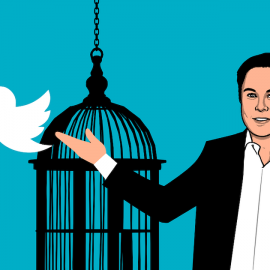

This article is an excerpt from the Shortform book guide to "Fix This Next" by Mike Michalowicz. Shortform has the world's best summaries and analyses of books you should be reading.
Like this article? Sign up for a free trial here.
Can you learn how to build brand loyalty? What does it take to create loyal customers?
To build brand loyalty, you need to have influence in your community. This means that you need to understand how to develop a strong company mission that your customers can connect to.
Read on to learn more about creating brand loyalty with social influence.
Inspire Loyalty Through Influence
A key part of learning how to build brand loyalty is learning how to influence people. Influence (or impact) is creating positive change for your community. To achieve influence, you must connect your company to a larger mission, which then encourages loyalty in your customers and employees—they see the good you’re doing with your mission and are inspired to support it. Loyal customers are more likely to buy your products and recommend them to others, while loyal employees are more likely to work hard to help your company succeed.
Here, we’ll highlight two components of building loyalty through influence:
Component #1: Identify Your Mission
Decide what kind of positive change you’re going to create for your community. This change doesn’t have to be dramatic; it’s more important that you and your employees are passionate about the way you’re helping people because that passion lets you persevere through difficult situations. One way to identify your mission is to look at how your company or industry harms your community and work to resolve it. For example, if you run a logging company, your mission might be to provide high-quality products (lumber) while minimizing your harmful effects on the environment.
(Shortform note: As an employee, how can you be passionate about your work if your company doesn’t have a clear mission? Some business experts suggest talking to your coworkers about how your work improves the world, even in small ways. Realizing the positive influence you already have can help you feel passionate about your work and persevere in creating positive change.)
| Mission vs. Purpose This definition of “mission” may be more commonly called “purpose” in the business world. A company’s purpose is often defined as the overarching reason it has certain goals or takes certain actions, and it often describes the way the company hopes to improve the world. In contrast, a company’s mission is often defined as the specific goals and actions that its purpose inspired—the concrete steps the company takes to create positive change. Going back to our logging example, these experts would likely define “providing high-quality products while minimizing your harmful effects on the environment” as your purpose. Your mission may be planting a sapling for every tree you cut down or rejecting clearcutting. If you connect your company to its current goals or actions (mission) instead of the purpose behind them, you may struggle to inspire loyalty among customers as well as employees. In Start With Why, Simon Sinek says that customers who believe in your company’s purpose are more likely to be loyal than those who simply like your company’s current goals or actions. These individuals are passionate about why you do things and will likely continue buying your products and working hard as long as you uphold that “why.” In contrast, people who focus on your company’s current goals or actions will likely stop supporting you if those things change. |
Component #2: Improve People’s Lives
Use your company to improve people’s lives—to give them a transformational experience. When you improve employees’ and customers’ lives, they become more loyal because, as discussed above, they’re inspired to help you continue your mission.
To help your employees, first, ask them about their passions and goals. Then, adjust their tasks and schedule to give them the time or money to pursue these passions and goals. As well as being inspired by your mission, your employees will be more likely to work hard and help the company succeed because they’re grateful: They know you made an extra effort to help them, so they’ll be more likely to do the same in return.
(Shortform note: Gratitude may improve work ethic through the reciprocity reflex. In The Happiness Hypothesis, Jonathan Haidt says humans have an evolutionary instinct to repay favors. Thus, if someone’s helped you in the past, you’re more likely to help them in return. This reflex evolved because it improved early humanity’s chances of survival, creating a network of obligation that encouraged everyone to care for each other.)
To help customers, provide goods or services that feel like they’re changing customers’ lives—the more significant the change, the better. For example, say you run a company that creates puzzle books. You might make your product feel life-changing by including facts and statistics in every chapter that show how completing puzzles improves brain function.
| Maximizing Happiness to Improve People’s Lives In Delivering Happiness, Tony Hsieh offers another method of improving employees’ and customers’ lives, using a three-level theory of happiness: 1. Fulfill expectations: You reach the lowest level of happiness by fulfilling the basic service standards needed to retain customers and employees. For example, customers expect to receive their purchases on time. If you regularly ship orders late, they’ll stop buying from you. This logic also applies to employees and their paychecks. 2. Fulfill desires: You reach the middle level of happiness by going beyond your community’s expectations and considering their desires. They may not expect to receive these benefits, but they want them and are happier with them. For instance, you may give free shipping to customers and full-coverage insurance to employees. 3. Fulfill unrecognized needs: You reach the highest level of happiness by improving customer and employee experiences in ways they haven’t thought of. They may not consciously want these benefits, but they’ll be happier with them. For example, you may give customers faster shipping and employees extra paid time off. As you reach these levels, your relationship with your employees and customers improves, encouraging loyalty. To maximize this improvement, Hsieh says to reach all three levels. This advice for improving employees’ lives arguably corresponds to level two of this scale, as asking employees about their passions and goals is a way to identify and meet their desires. Thus, once you provide time and money for your employees to pursue their passions, Hsieh would likely suggest that you find ways to fulfill their unrecognized needs. Further, this advice for improving customers’ lives can arguably encompass level three of Hsieh’s scale. You can do so by highlighting a life-changing benefit of your product or service that your customers might not have expected—one that surprises or delights them. |

———End of Preview———
Like what you just read? Read the rest of the world's best book summary and analysis of Mike Michalowicz's "Fix This Next" at Shortform.
Here's what you'll find in our full Fix This Next summary:
- Why many entrepreneurs struggle to fulfill their companies' requirements
- How to use the Business Hierarchy of Needs to prioritize company problems
- How to get to root problems rather than applying Band-Aid solutions






